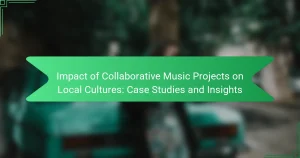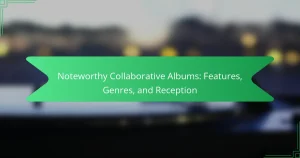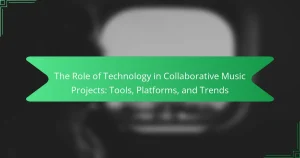Global music collaborations enhance cultural exchange and foster innovative sounds. This article explores key platforms like Spotify and YouTube, notable artists such as Shakira and Major Lazer, challenges faced during collaborations, regional audience perceptions, and emerging trends in genre fusion and technology integration. Understanding these dynamics reveals the profound cultural impact of music on a global scale.
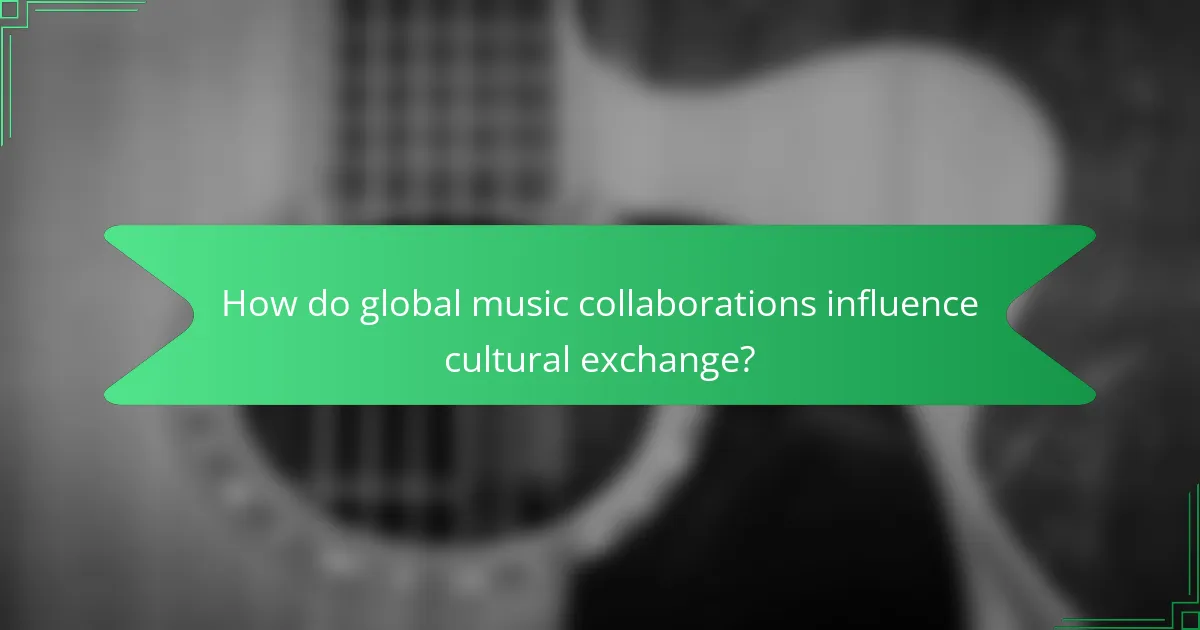
How do global music collaborations influence cultural exchange?
Global music collaborations significantly enhance cultural exchange by blending diverse musical styles and traditions. These partnerships foster mutual understanding and appreciation among different cultures, leading to innovative sounds. For instance, collaborations between artists from various genres often result in unique music that reflects a fusion of cultural backgrounds. As a result, listeners gain exposure to new perspectives and experiences, enriching their cultural landscape. This dynamic interaction not only promotes global unity but also preserves and revitalizes traditional music forms within contemporary contexts.
What role do artists play in bridging cultural divides?
Artists play a crucial role in bridging cultural divides by fostering collaboration and understanding across diverse communities. Global music collaborations unite artists from different backgrounds, creating unique sounds that reflect a blend of cultural influences. These collaborations often promote dialogue and empathy, breaking down stereotypes and encouraging cultural exchange. For instance, projects like “Playing for Change” bring together musicians worldwide, showcasing the power of music to transcend borders and connect people. Such initiatives illustrate how artists can serve as cultural ambassadors, using their creativity to inspire unity and appreciation for diversity.
Which genres are most commonly blended in collaborations?
Collaborations often blend genres like pop, hip-hop, and electronic music. These combinations create unique sounds and expand audience reach. For instance, pop artists frequently collaborate with hip-hop artists to merge catchy melodies with rhythmic verses. Similarly, electronic music often intersects with various genres, enhancing creativity and cultural exchange.
How do collaborations reflect social and political themes?
Collaborations in global music often mirror social and political themes, showcasing cultural unity and activism. Artists from diverse backgrounds unite to address issues like inequality, climate change, and human rights. For instance, the song “This Is America” by Childish Gambino highlights systemic racism and gun violence. Such collaborations can amplify messages, reaching wider audiences and sparking conversations. Additionally, genre fusion reflects cultural exchange and solidarity, illustrating how music serves as a powerful tool for social commentary and change.
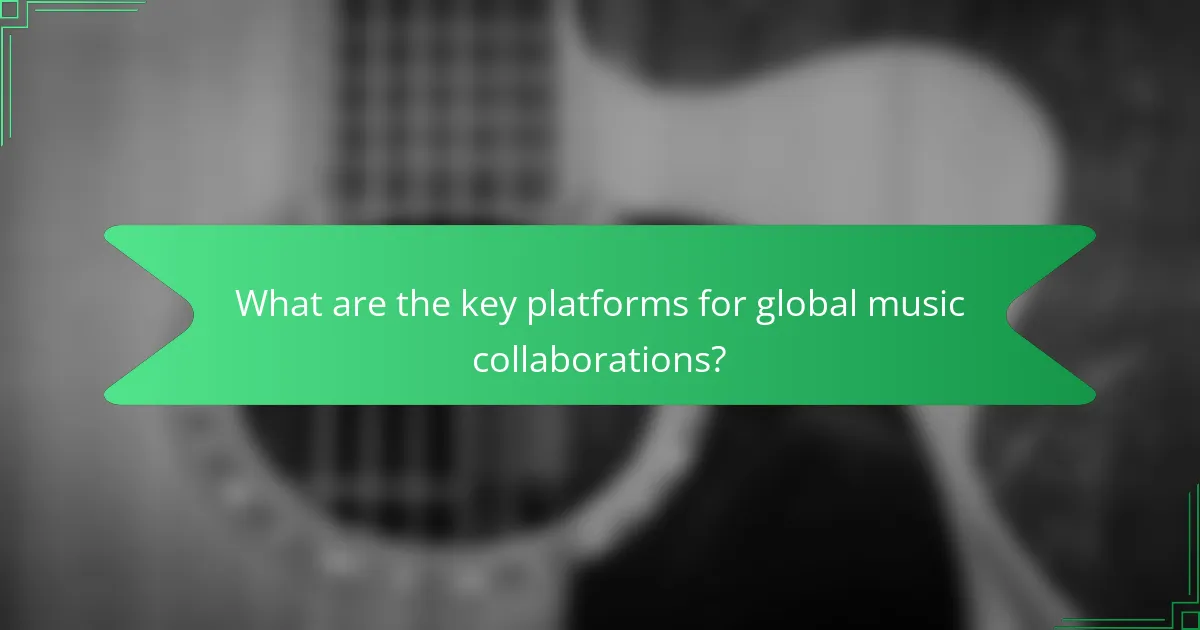
What are the key platforms for global music collaborations?
Key platforms for global music collaborations include social media, streaming services, and collaborative apps. These platforms enable artists to connect across genres and cultures, fostering innovative projects. Notable examples are SoundCloud, Spotify, and YouTube, which facilitate sharing and discovering diverse musical styles. Collaborative tools like Splice and BandLab allow musicians to create together in real-time, regardless of location. These platforms significantly enhance the cultural impact of music by promoting cross-cultural exchanges and broadening audience reach.
How do streaming services facilitate cross-genre partnerships?
Streaming services facilitate cross-genre partnerships by providing platforms for diverse artists to collaborate, reaching wider audiences. These services enable artists from different genres to combine their unique styles, resulting in innovative music that reflects cultural influences. For instance, collaborations between hip-hop and country artists have gained popularity, showcasing the blending of distinct musical traditions. Additionally, streaming algorithms promote cross-genre tracks, enhancing visibility and encouraging further collaborations. This synergy not only expands the musical landscape but also fosters cultural exchange, enriching the global music scene.
What impact do social media platforms have on collaboration visibility?
Social media platforms enhance collaboration visibility by enabling artists to share their work with a global audience. They facilitate real-time communication and feedback, fostering creative partnerships across genres and cultures. For instance, platforms like Instagram and TikTok allow musicians to showcase collaborative projects, amplifying their reach and cultural impact. This visibility can lead to increased fan engagement and new opportunities for artists, transforming how music collaborations are perceived and executed.
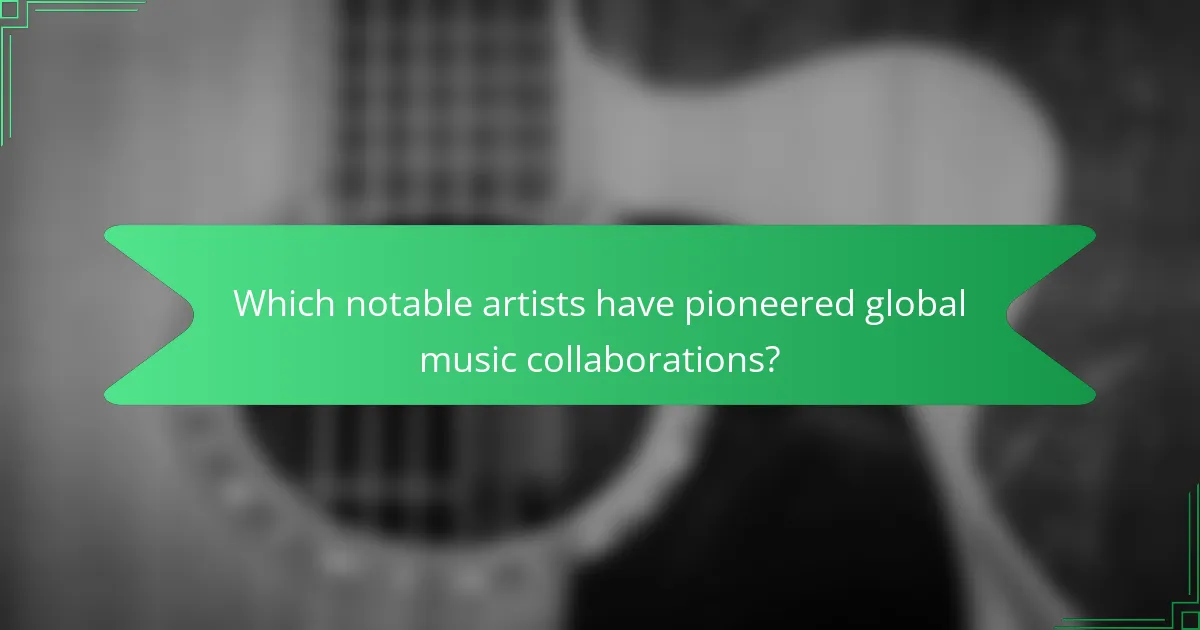
Which notable artists have pioneered global music collaborations?
Notable artists who have pioneered global music collaborations include Shakira, Pitbull, and Major Lazer. These artists blend various genres and cultural influences, creating a significant impact on the global music scene. For instance, Shakira’s collaboration with Wyclef Jean on “Hips Don’t Lie” showcased Latin pop’s reach, while Major Lazer’s fusion of electronic and reggae brought Caribbean sounds to a wider audience. Additionally, collaborations like “Despacito” by Luis Fonsi and Daddy Yankee featuring Justin Bieber highlight the power of cross-cultural partnerships in music.
What unique styles have emerged from these collaborations?
Unique styles from global music collaborations include fusions of genres, cross-cultural rhythms, and innovative instrumentation. Collaborations often blend traditional sounds with contemporary elements, creating unique musical experiences. Notable examples include Afrobeat’s integration with hip-hop and the merging of Latin rhythms with electronic music. These styles reflect cultural exchanges, enhancing global music’s diversity and appeal.
How do collaborations shape an artist’s career trajectory?
Collaborations significantly enhance an artist’s career trajectory by expanding their audience and creative reach. They allow artists to merge different genres, creating innovative sounds that attract diverse listeners. For instance, collaborations between pop and hip-hop artists often result in chart-topping hits, showcasing the power of genre blending.
Moreover, partnerships with international artists can introduce local musicians to global markets, increasing their visibility. This cultural exchange fosters unique artistic expressions, enriching the music landscape. Successful collaborations often lead to increased streaming numbers, higher concert attendance, and greater media attention, ultimately shaping an artist’s long-term career path.
In summary, collaborations drive artistic growth, audience expansion, and cultural impact, making them pivotal in an artist’s journey.
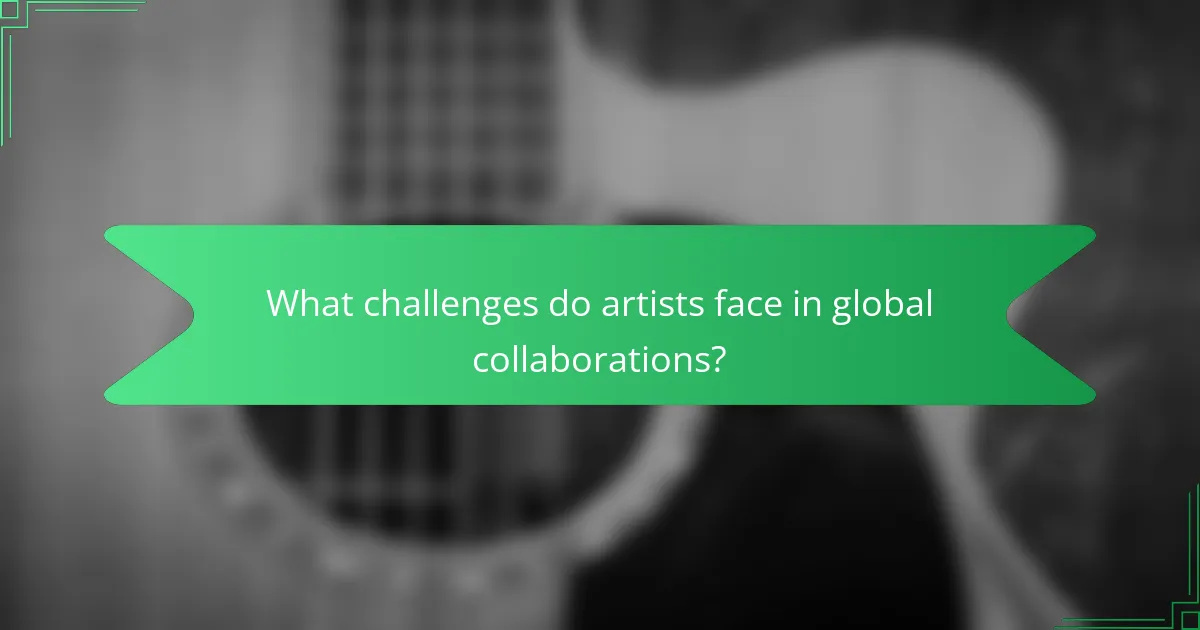
What challenges do artists face in global collaborations?
Artists face several challenges in global collaborations, including cultural differences, communication barriers, and varying industry standards. Cultural differences can lead to misunderstandings, affecting creative processes. Communication barriers often arise from language differences, complicating collaboration. Additionally, artists may encounter differing expectations regarding production quality and distribution methods across regions. These factors can hinder the effectiveness of collaborative projects and impact the overall cultural impact of the music produced.
How do language barriers affect the creative process?
Language barriers can hinder collaboration in global music by limiting communication and expression. Artists may struggle to convey their ideas, emotions, and cultural nuances, impacting creativity. For instance, misunderstandings can lead to misinterpretations of musical styles or themes. This can also result in missed opportunities for innovative fusion genres. However, collaboration tools and technology can help bridge these gaps, allowing artists to overcome language challenges and enhance their creative processes.
What legal considerations must be addressed in international collaborations?
International collaborations in music require addressing legal considerations such as copyright, licensing, and jurisdiction. Artists must ensure compliance with local laws and international treaties. Clear agreements on revenue sharing, intellectual property rights, and dispute resolution mechanisms are essential. Additionally, understanding cultural differences in legal frameworks can impact collaboration success.
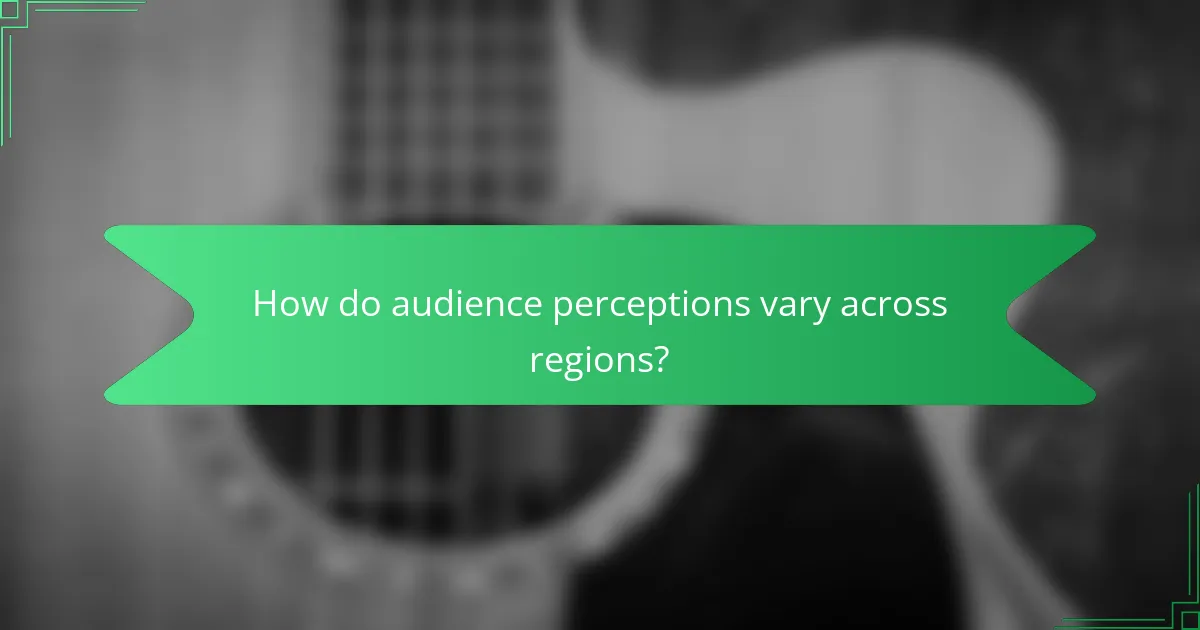
How do audience perceptions vary across regions?
Audience perceptions of global music collaborations vary significantly across regions due to cultural influences, genre preferences, and local music scenes. For instance, in North America, collaborations often blend pop and hip-hop, appealing to mainstream audiences. In contrast, European listeners might favor electronic and indie genres, valuing artistic experimentation. In Asia, traditional elements often merge with contemporary styles, reflecting rich cultural heritages. These regional differences shape how collaborations are received, impacting chart performance and audience engagement. Understanding these nuances is crucial for artists aiming to reach diverse global markets.
What cultural factors influence the reception of collaborative works?
Cultural factors significantly influence the reception of collaborative works in global music. These factors include cultural heritage, language, and social norms.
Cultural heritage shapes artists’ styles and influences audience expectations. For instance, collaborations between artists from different backgrounds often blend diverse musical traditions, creating unique sounds. Language plays a crucial role in accessibility and relatability, as lyrics in familiar languages resonate more with local audiences.
Social norms dictate the acceptance of collaborations, affecting how audiences perceive genre fusions. In some cultures, genre-blending is celebrated, while in others, it may face resistance.
Overall, understanding these cultural factors enhances the effectiveness of global music collaborations.
How do demographics shape listening preferences for collaborations?
Demographics significantly influence listening preferences for collaborations. Factors such as age, cultural background, and geographic location shape how audiences engage with music. Younger listeners often prefer collaborations that blend genres, reflecting a desire for innovation. In contrast, older demographics may favor traditional styles, valuing established artists and cultural authenticity. Additionally, cultural context impacts genre preferences, with regional influences shaping the appeal of specific collaborations. As a result, understanding these demographic nuances helps artists tailor their collaborations to resonate with diverse audiences.
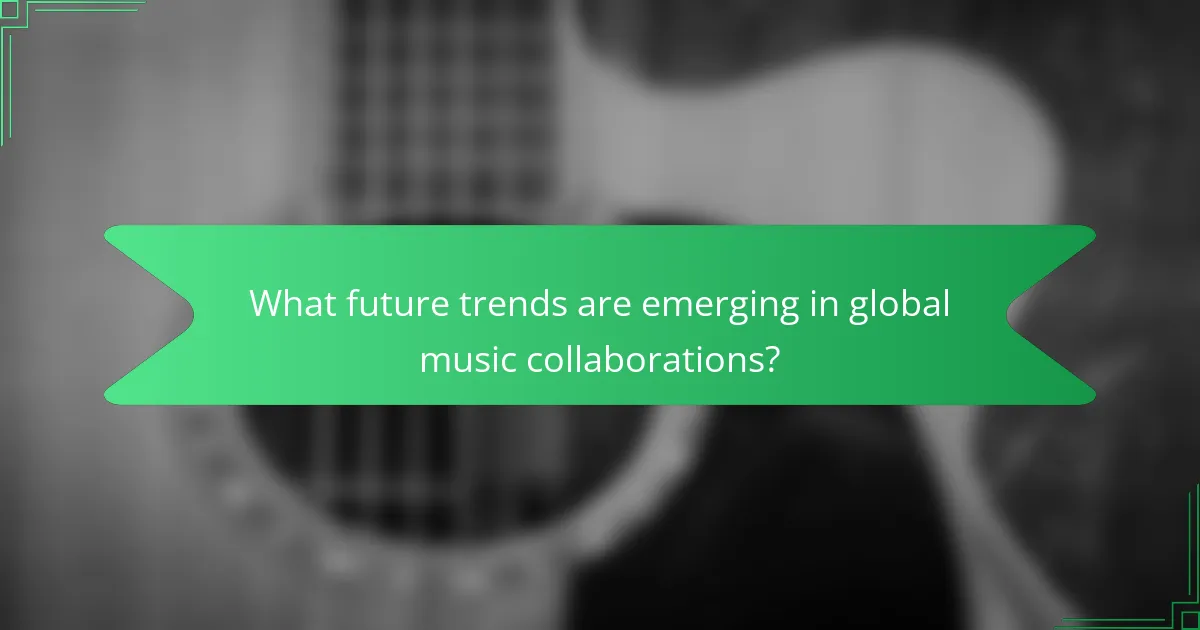
What future trends are emerging in global music collaborations?
Emerging trends in global music collaborations include genre fusion, technology integration, and cultural exchange. Artists are increasingly blending styles, creating unique sounds that resonate worldwide. Digital platforms facilitate cross-border collaborations, allowing diverse artists to connect easily. Additionally, cultural influences shape music, promoting inclusivity and representation in the industry. These trends enhance global music’s richness and accessibility.
How is technology shaping the future of music partnerships?
Technology is transforming music partnerships by enabling diverse collaborations across genres and cultures. Digital platforms facilitate real-time connections and creative exchanges among artists worldwide. Innovations like AI and streaming services enhance accessibility, allowing unique genre fusions and broader cultural impacts. As a result, artists can reach global audiences, creating a richer musical landscape.
What role will virtual collaborations play in the coming years?
Virtual collaborations will significantly enhance global music interactions, fostering cross-genre and cross-cultural partnerships. Artists can easily connect regardless of geographic boundaries, leading to innovative music styles. For example, collaborations between hip-hop and traditional folk music are becoming more common, enriching both genres. As technology advances, virtual platforms will facilitate real-time collaboration, enabling artists to produce music together from different locations. This trend will amplify cultural exchange, allowing diverse influences to shape the future of music.
What are the best practices for successful global music collaborations?
Successful global music collaborations thrive on clear communication, cultural understanding, and mutual respect among artists. Establishing a shared vision enhances creativity and fosters innovation.
Building relationships through networking is crucial. Collaborating with artists from diverse backgrounds enriches the creative process and broadens audience reach.
Utilizing technology facilitates seamless collaboration across distances. Tools for virtual communication and file sharing streamline the creative workflow.
Embracing cultural nuances can lead to unique musical fusions. Artists should be open to experimenting with different genres and styles, creating a blend that resonates with various audiences.
